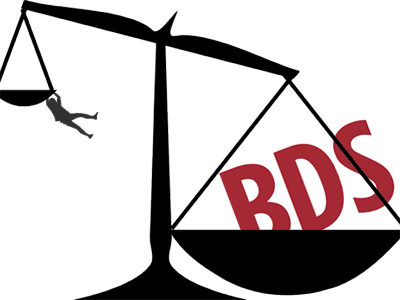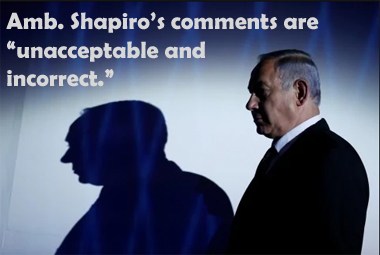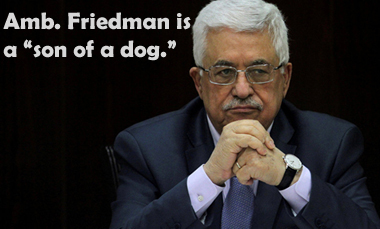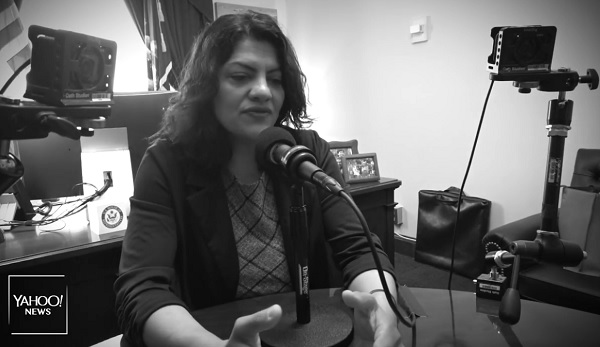Recent Entries:
Author: gi
March 22, 2021
NY Times Defends Holocaust-Inversion
The historian Deborah Lipstadt described Holocaust inversion — the act of described Jews in Israel as the new Nazis — as a form of “soft-core denial.” This style of Holocaust denial is part of an equation that, when looked at from one direction, amounts to hateful anti-Israelism, and from the other, as no less than historical revisionism about the Nazis. In Lipstadt’s words, Holocaust inversion is “a false comparison which elevates by a factor of a zillion any wrongdoings Israel might have done, and lessens by a factor of a zillion what the Germans did.”
It seems that Mike Isaac, a tech writer for the the New York Times, would prefer his readers think of the phenomenon as innocent commentary—certainly not something that a social-media site should regard as hateful speech.
Isaac’s March 19 piece in the paper’s Technology section speaks of how Facebook’s algorithms, and even its human moderators, sometimes fail to recognize satire and so wrongly flag as hate-speech political cartoons that are in fact meant to mock and highlight hate-speech. Or as the story’s headline and subhead put it, “For Political Cartoonists, the Irony Was That Facebook Didn’t Recognize Irony; As Facebook has become more active at moderating political speech, it has had trouble dealing with satire.”
As an example, the piece points to a cartoon mocking violent inclinations of the far-right “Proud Boys,” which Facebook removed from its site because it wrongly interpreted the cartoon as “advocating violence.”
Later in the piece, the author turned to what he cast as another example of Facebook screwing things up:
When Prime Minister Benjamin Netanyahu said in 2019 that he would bar two congresswomen — critics of Israel’s treatment of Palestinians — from visiting the country, Mr. Hall drew a cartoon showing a sign affixed to barbed wire that read, in German, “Jews are not welcome here.” He added a line of text addressing Mr. Netanyahu: “Hey Bibi, did you forget something?”
Mr. Hall said his intent was to draw an analogy between how Mr. Netanyahu was treating the U.S. representatives and Nazi Germany. Facebook took the cartoon down shortly after it was posted, saying it violated its standards on hate speech.
Here’s the cartoon in question:
In the view of many Jews and others, the content of this cartoon is indeed an example of hate speech. It’s not only Deborah Lipstadt, who specializes in the history of the Holocaust, who has argued as much. The International Holocaust Remembrance Alliance (or IHRA), a multinational Holocaust-education organization, includes in its definition of antisemitism the following example of the hatred: “Drawing comparisons of contemporary Israeli policy to that of the Nazis.” (A similar definition was used by the Obama-era State Department.)
And so a Times piece meant to show Facebook failing recognizing the difference between hate and satire itself failed to distinguish between Holocaust minimization and innocent irony. What more should we expect from a newspaper with a history of failing to recognize antisemitism?
April 2, 2020
When Palestinians Like Checkpoints
To some pundits, it goes without saying that checkpoints in the West Bank should be discussed with the bleakest of terms.
The checkpoints Israel erected in the West Bank during waves of Palestinian suicide bombings are understood by Israelis to be life-saving, and there is no shortage of examples they could point to of would-be bombers stopped at a checkpoint before they could reach their target.
Outside of Israel, though, they are often cast in a different light. They inflict “moral and physical suffering” for no other reason than to “humiliate and intimidate another people,” insisted a pair of foreign visitors to the West Bank wrote the New York Times international edition, having once passed through a checkpoint.
“I can no longer endure the anxiety” caused in part by traffic created by checkpoints, insisted Raja Shehadeh, a frequent New York Times contributor who just last week absurdly claimed Israel’s curfew on the West Bank in 2002 was imposed as “normal life” continued in the Jewish state, though 2002 was a year of relentless Palestinian suicide bombings and hundreds of Israeli deaths, unprecedented in Israeli history.
“Some of the checkpoints create terror rather than prevent it,” declared the head of an advocacy group.
It was striking, then, to hear NPR correspondent Daniel Estrin reference West Bank checkpoints this Tuesday on Morning Edition as follows:
There are over a hundred cases of Palestinians who have caught the [corona]virus in the West Bank. … And Palestinian authorities very quickly imposed lockdowns even earlier than Israel did, much stricter lockdowns. It’s very difficult to move around in the West Bank. Palestinians can’t drive between cities. There are checkpoints that Palestinian security officials have set up. And Palestinians are rallying around their leadership right now. They like these strict measures.
The approval of these “strict measures” makes sense. Burdensome interventions like checkpoints are sometimes necessary to save Palestinian lives. When the alternative is hospitalization or death for sick Palestinians, they not only can handle restrictions on movement, but welcome them.
Editors rushing to print hyperbole about Israeli measures might also keep in mind that burdensome interventions like checkpoints are also sometimes necessary to save Israeli lives, too.
March 16, 2020
NY Times Shows How Framing Slants Coverage
A couple of days ago, we highlighted how David Halbfinger, the New York Times bureau chief in Jerusalem, cast Israel’s prime minister as a scold for, well, trying to protect vulnerable populations from a pandemic.
If that’s how Halbfinger responds to helpful messages from the Israeli government, we noted, it should come as no surprise that, on the same day, the journalist also suggested Israel denies its Arab population democracy, simply because many Jewish lawmakers are skeptical of partnering with the Joint List. The Joint List is a mostly Arab political alliance that includes a communist party, an Islamist party, and lawmakers who reject the continued existence of the Jewish state and have praised terrorists.
Today, Halbfinger followed up with a piece noting that the Joint List itself refuses to join the Israel government. The contrast between his framing of Jewish lawmakers who don’t want Joint List to be part of the government and Arab lawmakers who don’t want to be part of the government is telling.
In exhibit one, from the New York Times‘s March 12 story, Halbfinger frames Jewish Knesset members who don’t think the Arab List party should be part of the government as racists who see Arabs as “enemies.” The political gulf is proof of bad behavior by Israeli Jews.
In exhibit two, from today’s story, the shoe is on the other foot. We have Joint List Knesset members who don’t want to join Jewish lawmakers in a government. The distaste goes both ways. But this time, Halbfinger doesn’t wave the point around as proof that the mostly Arab MKs see Jews as “the enemy.” Readers aren’t told that the lawmakers reject the legitimacy of Jewish votes. Instead, the story is again framed in terms of what readers will see as bad behavior by Israeli Jews:
November 13, 2019
Again, NY Times Silent on Islamic Jihad Terror Designation
As we noted yesterday, the New York Times chose to remove the word “terror” from its article about fighting between Palestinian Islamic Jihad and Israel. While early versions of the story informed readers that Islamic Jihad is recognized internationally as a terrorist group, that information was scrubbed from the article shortly after 9am in New York.
Today’s follow-up story on the fighting, too, neglects to tell readers of Islamic Jihad’s terror designation. In fact, it’s been over six months since the paper informed readers that the group is listed as a terror organization.
CAMERA’s article yesterday pointed out that the Times repeatedly used the T-word after the U.S. operation that lead to the death of ISIS leader Abu Bakr al Baghdadi. But we don’t have to look even that far back. Today and yesterday, on the very days the newspaper avoided noting — made edits to avoid noting — Islamic Jihad’s terror designation, it did see fit to inform readers that, e.g.,
• “Turkey regards the Syrian Kurdish militia [SDF] as a terrorist organization”;
• and that “Turkey also considers the Islamic State a terrorist organization”;
• and that the Chinese government claims Hong Kong protesters are engaged in “brazen terrorism”;
• and that ISIS is a “terror group.”So why weren’t readers informed that Islamic Jihad is considered a terrorist group by the US, EU, Canada, UK, Australia, New Zealand and others? Is it somehow less important to share fundamental context about an organization that targets Jewish-Israeli civilians?
August 7, 2019
A Skewed NY Times Story on BDS, Then a Skewed Letters Section
After the New York Times published a skewed story about the anti-Israel BDS campaign, we detailed how the newspaper’s reporters “put their fingers on the scales in support of BDS.”
One of the many examples we noted: The authors quoted all of five words by critics of the BDS movement, which seeks to eliminate Israel. (This was alongside over 75 quoted words by the movement and its founders.)
The newspaper hardly did better in its subsequent Letters section, which was likewise skewed in favor of anti-Israel and pro-BDS voices.
In all, three short letters totaling 308 words focused on criticism of the BDS campaign. In the remaining five letters, 815 words were dedicated to defending BDS, attacking Israel, and slamming critics of BDS.
So the final words of our critique of the Times news story bear repeating, this time about the Letters section:
If the BDS movement’s few successes were “public-relations victories,” as the Times put it, perhaps it is only because they have people in the media who serve as good PR agents. The New York Times reporters might want to consider how they fit in to this.
July 9, 2019
NY Times Cites Poll, Hides Palestinian Support for Violence
The New York Times has struggled to accurately describe polls this year. In January, editor Jonathan Weisman misrepresented Pew polling data to describe a nonexistent surge in Israeli support for the United States under President Trump.
In March, David Halbfinger, the newspaper’s bureau chief in Jerusalem, took liberties with another Pew poll, again in order to cast Israelis in a negative light.
The newspaper did somewhat better in today’s article, by Isabel Kershner, about a decrease in Palestinian protests. Kershner points to a recent poll to help give readers a sense of Palestinian attitudes toward “nonviolent resistance.”
“An opinion poll by the Ramallah-based Palestinian Center for Policy and Survey Research in June found that only 23 percent of Palestinians saw nonviolent resistance as the most effective way of achieving statehood,” she wrote. And indeed, the July poll did include such a finding. But that’s a very partial account of the poll.
In the context of Kershner’s piece, which refers to a “lull in grass-roots protests” and a “relative calm” that the author attributes in part to “war weariness” on the part of the Palestinians, and which spotlights Palestinians who are more interested in jobs than demonstrations, the poll finding seems to be evidence of Palestinian abandoning their belief in conflict.
But a closer look at the survey itself, by the Palestinian Center for Policy and Research, tells a very different story. In part, the reason a relatively small proportion of Palestinians support nonviolent protest is because a relatively large proportion support armed violence.
The poll found that
• “34% prefer waging ‘an armed struggle against the Israeli occupation.’”
• “38% think armed struggle is the most effective means” of achieving statehood.
• “38% chose armed struggle” as the most effective means of ending the occupation.
• “47% support a return to an armed intifada”In other words, depending on how the question is worded between one third and one half of the population support violence against Israel—violence that has typically involved attacks on civilians. This is no less relevant, and perhaps more important for reader understanding of the conflict, than the finding shared by the Times about low levels of support for nonviolent resistance.
But the newspaper ignored the more incriminating poll results that contextualize the finding Kershner shared and shine a light on Palestinian views in general. Why?
June 10, 2019
Not a Scoop: 448 Days Later, NY Times Reports Slur by Palestinian Leader
In January 2016, on the day Israel buried a pregnant woman stabbed to death by a Palestinian terrorist, the U.S. Ambassador to Israel publicly criticized what he viewed as a double standard in Israelis law enforcement that allows for “unchecked” vigilantism in the West Bank. Israel’s prime minister responded that the remarks were “unacceptable and incorrect.” (The ambassador later expressed regret for the timing of his comments.)
It took the New York Times only hours to report that the Israeli prime minister had critiqued the U.S. ambassador to Israel, and four days to slam that critique as “unusually personal and unfair” in an editorial.
Two years later, in March 2018, the Palestinian leader slurred the American ambassador as a “son of a dog.”
The time it took for the newspaper to report on that “unusually personal” slur can also be counted in days: 448 in all.
Yes, well over a year after Mahmoud Abbas hurled curses at Ambassador David Friedman’s mother, the New York Times has finally ended Abbas’s undiplomatic immunity and printed his words for all to see — even if only because Friedman recounted them in an interview with the newspaper.
It wouldn’t be “unusually personal and unfair” to point out that this wasn’t a scoop by the New York Times.
For our original coverage of the Times double standard relating to the ambassadors’ statements, see here.
May 31, 2019
After Broadcasting Holocaust Denial, AJ+ Feigns Innocence
After Al Jazeera created and posted a video questioning “the truth of the Holocaust,” officials at the Qatari media giant took a page from the New York Times‘ book, blaming employees who were working “without due oversight.” (The Times had blamed its recent anti-Semitic cartoon on “a single editor acting without adequate oversight.”)
The video, by Al Jazeera’s pseudo-progressive AJ+, dismissed the Nazi murder of six million Jews as dubious “Zionist claims.” According to a translation by MEMRI, the video claimed that
the number of victims of the Holocaust remains one of the most prominent historical debates to this day. People are divided between those who deny the annihilation, others who think that the outcome was exaggerated, and others yet who accuse the Zionist movement of blowing it out of proportion in the service of the plan to establish what would later be known as the ‘State of Israel.’
According to an article on Al Jazeera’s website, “Dr. Yaser Bishr, Executive Director of Digital Division, stated that Al Jazeera completely disowns the offensive content in question and reiterated that Al Jazeera would not tolerate such material on any of the Network’s platforms.”
But that’s not true. It has long tolerated Holocaust denial, and has played an important role in spreading it. In 2009, for example, Al Jazeera broadcast Yousef Al-Qaradawi’s speech about Hilter’s “punishment” of the Jews: “By means of all the things he did to them—even though they exaggerated this issue—he managed to put them in their place. This was divine punishment for them.”
“Allah willing, the next time will be at the hand of the believers,” Qaradawi continued.
Al Jazeera viewers were also treated to Qaradawi calling for a new genocide: “Oh Allah, Take This Oppressive, Jewish, Zionist Band Of People; Oh Allah, Do Not Spare A Single One Of Them; Oh Allah, Count Their Numbers, And Kill Them, Down To The Very Last One.”
In 2007, Al Jazeera aired broadcast a speech by Hamas leader Khaled Mashal in which he delivered a similar message to the AJ+ Holocaust-revisionism video: “I want to make it clear to the West and to the German people, which is still being blackmailed because of what Nazism did to the Zionists, or to the Jews. I say that what Israel did to the Palestinian people is many times worse than what Nazism did to the Jews, and there is exaggeration, which has become obsolete, regarding the issue of the Holocaust. We do not deny the facts, but we will not give in to extortion by exaggeration.”
So much for Yaser Bishr’s claim that Al Jazeera “would not tolerate” Holocaust denial. See more at MEMRI.
May 14, 2019
Rashida Tlaib Says Palestinians “Provided” Jewish Haven
As is often the case in politics, much of the back and forth over Rashida Tlaib’s latest inflammatory comments — this time about the Palestinians and the Holocaust — seemed to be about partisan point-scoring more than the basic accuracy of her claims.
No, Tlaib didn’t say that the Holocaust per se makes her feel good.
And no, criticism of Tlaib’s comments isn’t driven by a smear campaign motivated by her religion, skin color, or party affiliation.
In her appearance on the Skullduggery podcast, Tlaib promoted the argument that her Palestinian ancestors suffered “in the name of trying to create a safe haven for Jews” after the Holocaust. She also said she got a “calming feeling” when thinking about the Holocaust because, in her words, “I love the fact that it was my ancestors that provided that [safe haven] — right? — in many ways.”
But as many critics pointed out, Tlaib’s revisionist account of history conceals and upends what actually happened. In the Atlantic, Benny Morris reminds readers that, far from “providing” shelter, the Palestinian leadership violently opposed a safe haven for Jews, and even collaborated with Hitler:
The Palestinians indirectly, and in some ways directly, aided in the destruction of European Jewry.
After Hitler’s accession to power in Germany in 1933, German and then Eastern European Jews sought escape and safe havens. But all the Western countries, including the United States and Britain and its dominions, closed their doors to significant Jewish immigration. Palestine emerged as the only potential safe haven. In 1932, the British allowed 9,500 Jews to immigrate to Palestine. In 1933, the number shot up to 30,000, and in 1935, it peaked at 62,000.
But from 1933 onward, Palestine’s Arabs—led by the cleric Muhammad Haj Amin al-Husseini, the grand mufti of Jerusalem—mounted a strident campaign to pressure the British, who governed Palestine, to bar all Jews from entering the country. To press home their demand, in 1936 they launched an anti-British and anti-Zionist rebellion that lasted three years. Apart from throwing out the British, the rebellion’s aim was to coerce London into halting all Jewish entry into Palestine.
Moreover, the anti-Jewish violence, which claimed the lives of hundreds of Jews and wounded many more, itself served to deter would-be emigrants from seeking to move to Palestine. British entry certificates for Jews to Palestine declined to 30,000 in 1936, 10,000 in 1937, and 15,000 in 1938. Those who couldn’t get in were left stranded in Germany, Poland, Hungary, and elsewhere. Almost all died in the Holocaust, which the Germans unleashed in 1941.
But the Palestinians’ contribution to the Holocaust was also more direct. Husseini, having fled Palestine during the revolt, helped pro-Nazi generals launch an anti-British rebellion in Iraq in 1941 (which itself engendered a large-scale pogrom against Baghdad’s Jews, the Farhoud). When that rebellion failed, he fled to Berlin, where he was given a villa and a generous monthly salary, and lived in comfort until the end of the world war. During the war, he helped recruit Muslims from the Balkans for the German army and the SS, and in radio broadcasts exhorted Middle Eastern and North African Arabs to launch jihad against the British and “kill the Jews.”
April 4, 2019
The New York Times’ Slow Reaction to Hamas Crackdown on Palestinian Protesters
The New York Times took a slight jab at Hamas, the terrorist organization that rules the Gaza Strip, in a recent story about Hamas’s crackdown on Palestinian protesters who spoke out against its policies in Gaza.
The March 24 story, which points out that Hamas beat protesters and journalists and arrested about 1000 of its citizens, made a point of contrasting the government’s “assiduous” reporting on casualties during violent anti-Israel riots with its silence about those injured during the internal protests:
Gaza’s Health Ministry, which has assiduously reported on the nearly 200 Palestinians killed and thousands wounded by Israeli troops during often-violent protests along the fence dividing Gaza from Israel, has not reported the number injured by Hamas in quelling the protests.
Indeed. What the Times doesn’t tell you, though, is that it’s guilty of the very same discrepancy.
While the newspaper gave some press to last year’s anti-Israel protests already during the planning stages, days before rioters first gathered on the Israel-Gaza border, its March 24 story was the first time the reporters seriously covered the Hamas crackdown, which had been going on for two weeks with hardly a passing mention.
Here’s a (partial) timeline that shows when Times reporters, eventually, decided to run a story on the violence:
• March 10: Hamas arrests, and reportedly tortures, 13 Palestinian activists planning the demonstrations.
• March 14: The protests and crackdown begin. The Associated Press covers the story, noting that “Videos circulated on social media showed police firing live rounds in the air, beating protesters and hauling them into police vehicles.”
• March 15: Haaretz reports on “Hamas police officers shooting, beating and arresting protesters, as well as detaining journalists and human rights activists,” and CBS News is among the news outlets worldwide picking up AP coverage about how Hamas “violently broke up a rare protest by demonstrators angry about the dire living conditions in Gaza.”
• March 16: AP, China’s Xinhua, and Palestinian reporters in the West Bank are among those reporting on the unrest.
• March 17: Reuters and the Jerusalem Post are among those covering the crackdown and noting that the UN’s Special Coordinator for the Middle East Peace Process strongly condemned the “campaign of arrests and violence used by Hamas security forces against protesters, including women and children, in Gaza over the past three days” and the “brutal beating” of reporters and rights activists.
• March 18: Amnesty International decries “beatings, arbitrary arrest and detentions, and torture and other forms of ill-treatment since 14 March.” In the UK, the Telegraph reports serious injuries as “videos appeared to show officers clubbing unarmed protesters.”
• March 19: AP, CNN, NPR, Al Jazeera, the Independent, and Ma’an are among those covering the Hamas violence.
• March 20: Human Rights Watch publishes a report and
Hamas itself acknowledges the story, apologizing ” for any psychological or material harm inflicted on any Palestinian citizen.”• March 21: On the Opinion pages, a New York Times columnist criticizes his own newspaper’s failure to cover the crackdown, saying it, and the Western press in general, “for too long has been depressingly incurious about any form of Palestinian suffering for which Israel cannot be held responsible.”
• March 22: etc…
• March 23: etc…
• March 24: … and finally, the news pages of the paper that promises “all the news fit to print” gets around to writing a story about the crackdown.
Why so slow? See the March 21 entry above.
Search:
Search this site:












